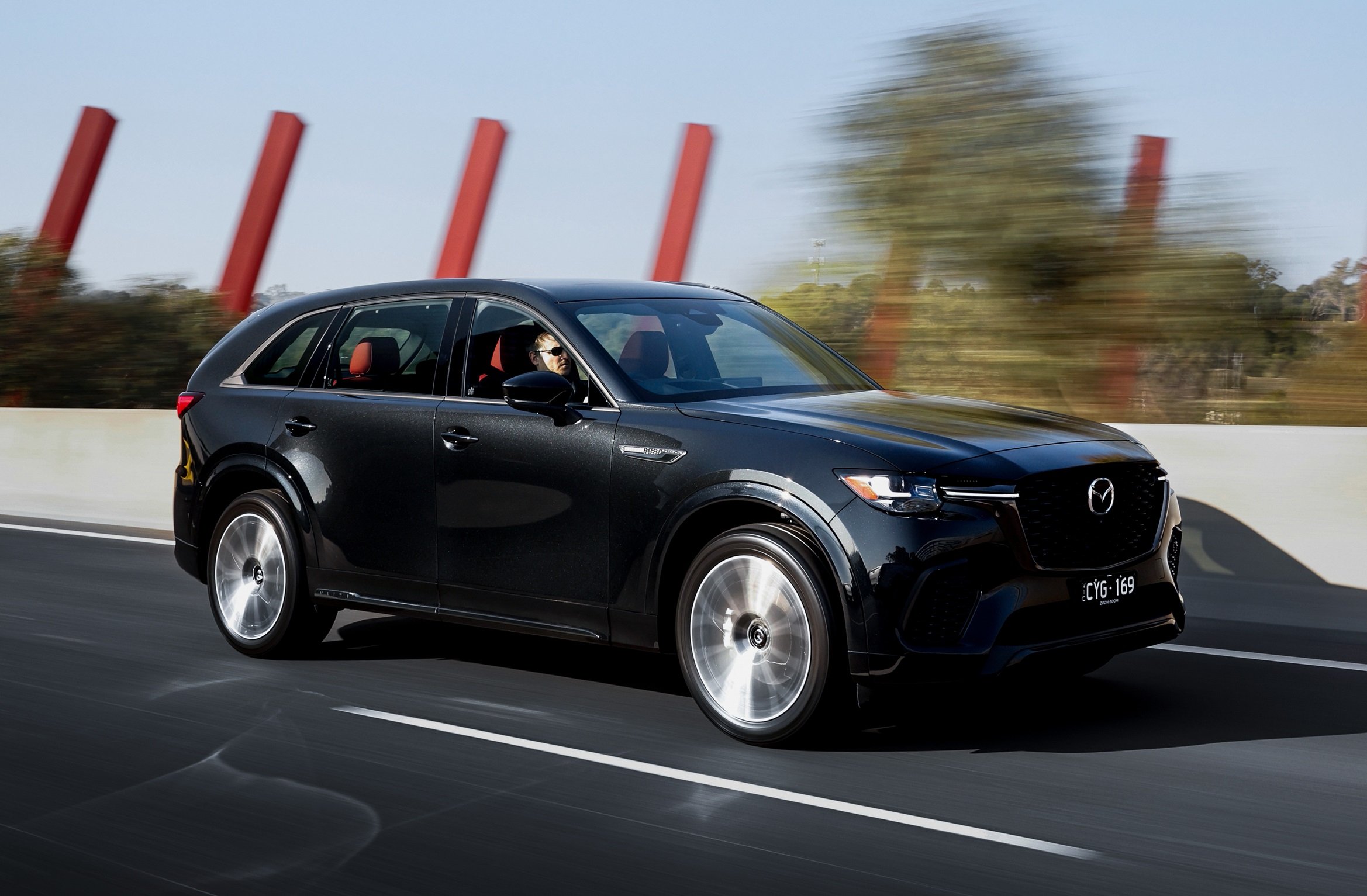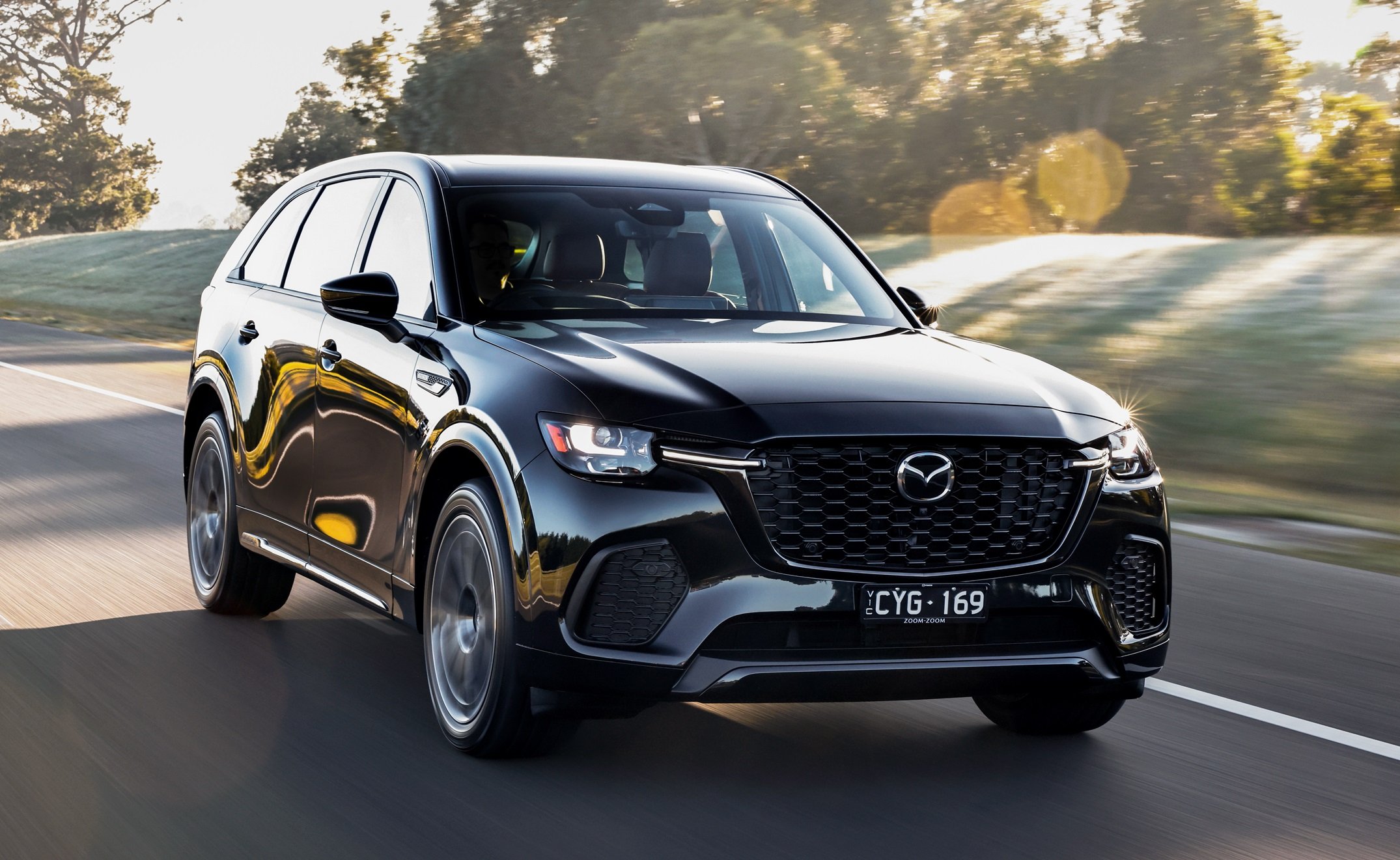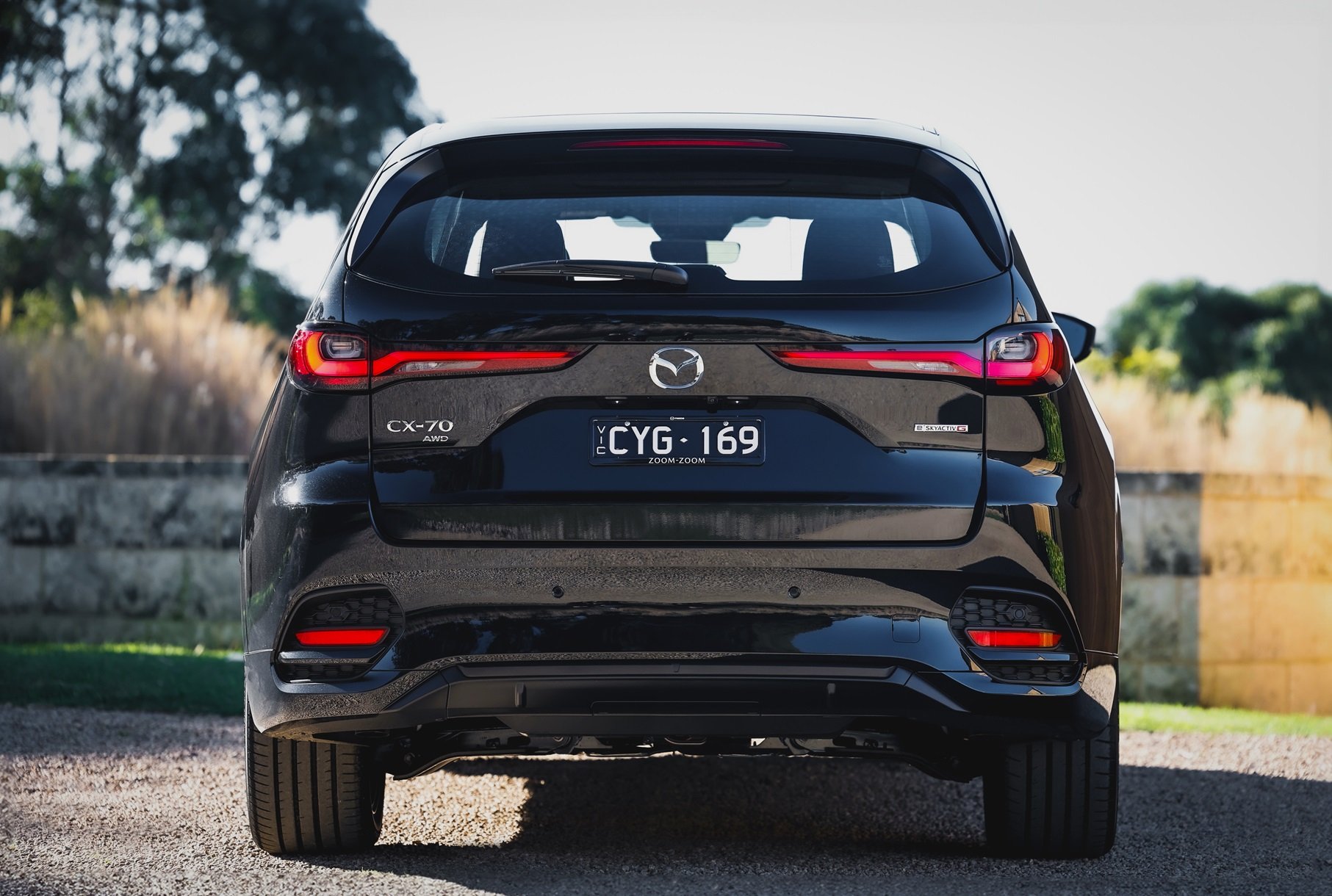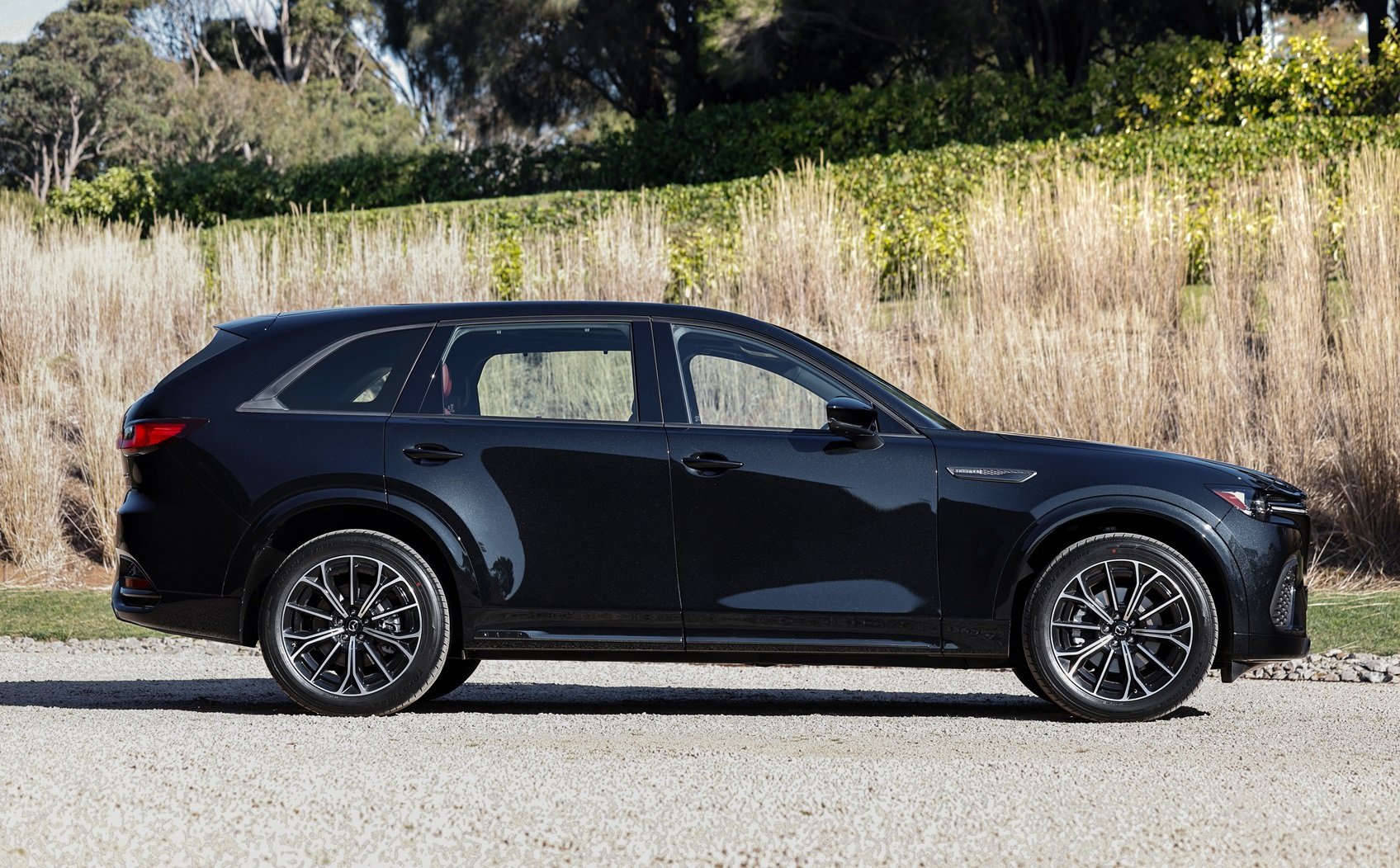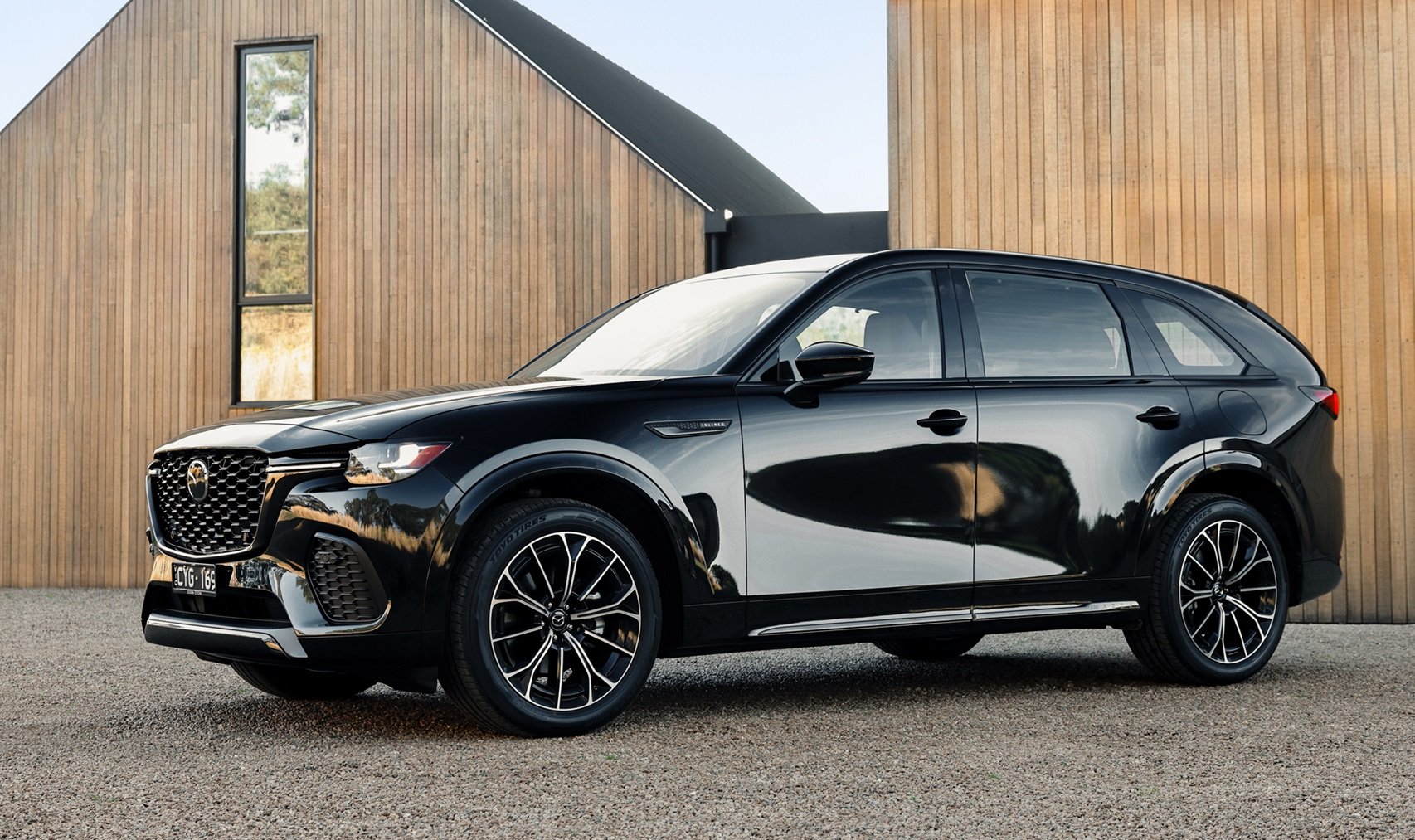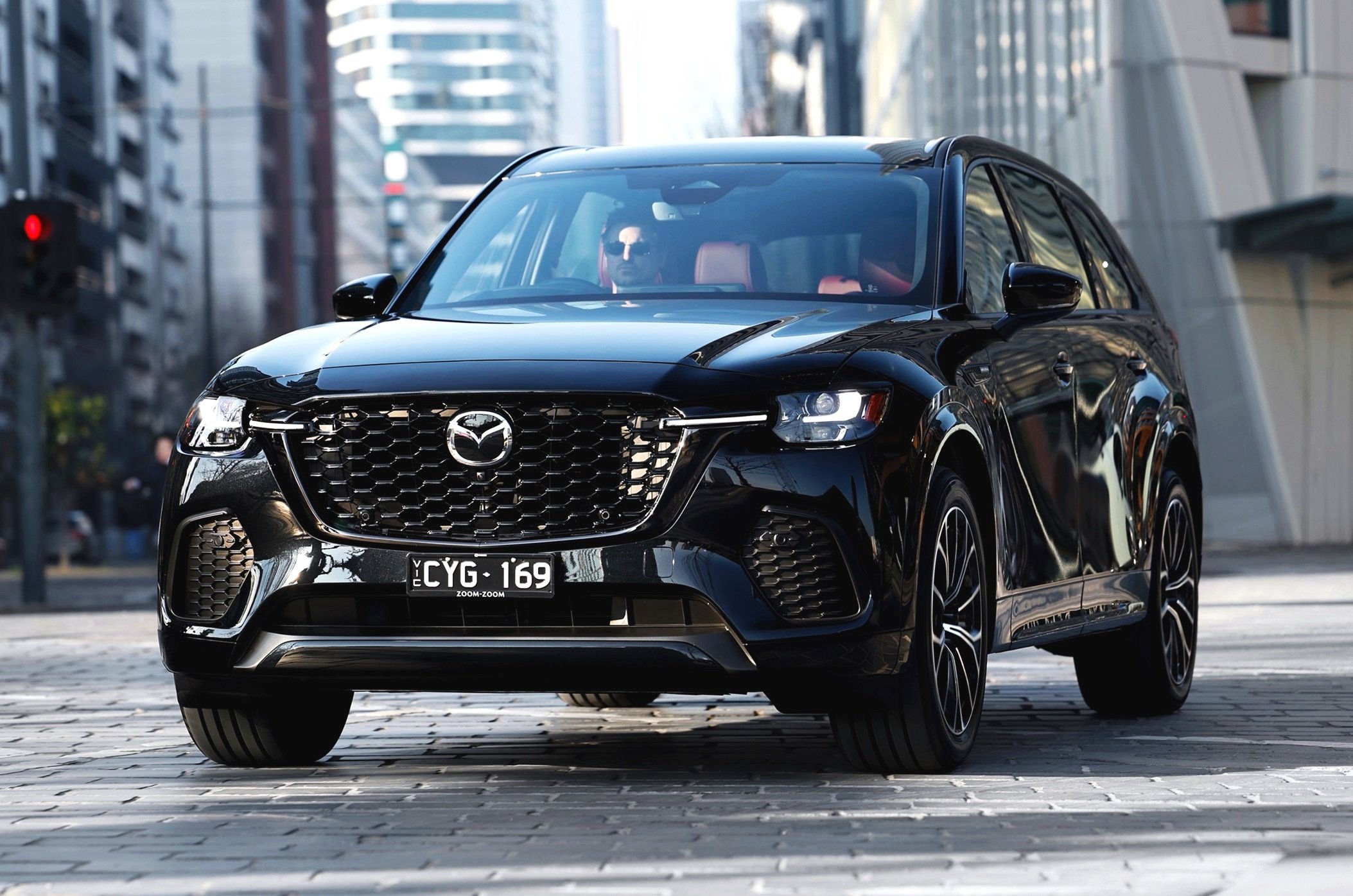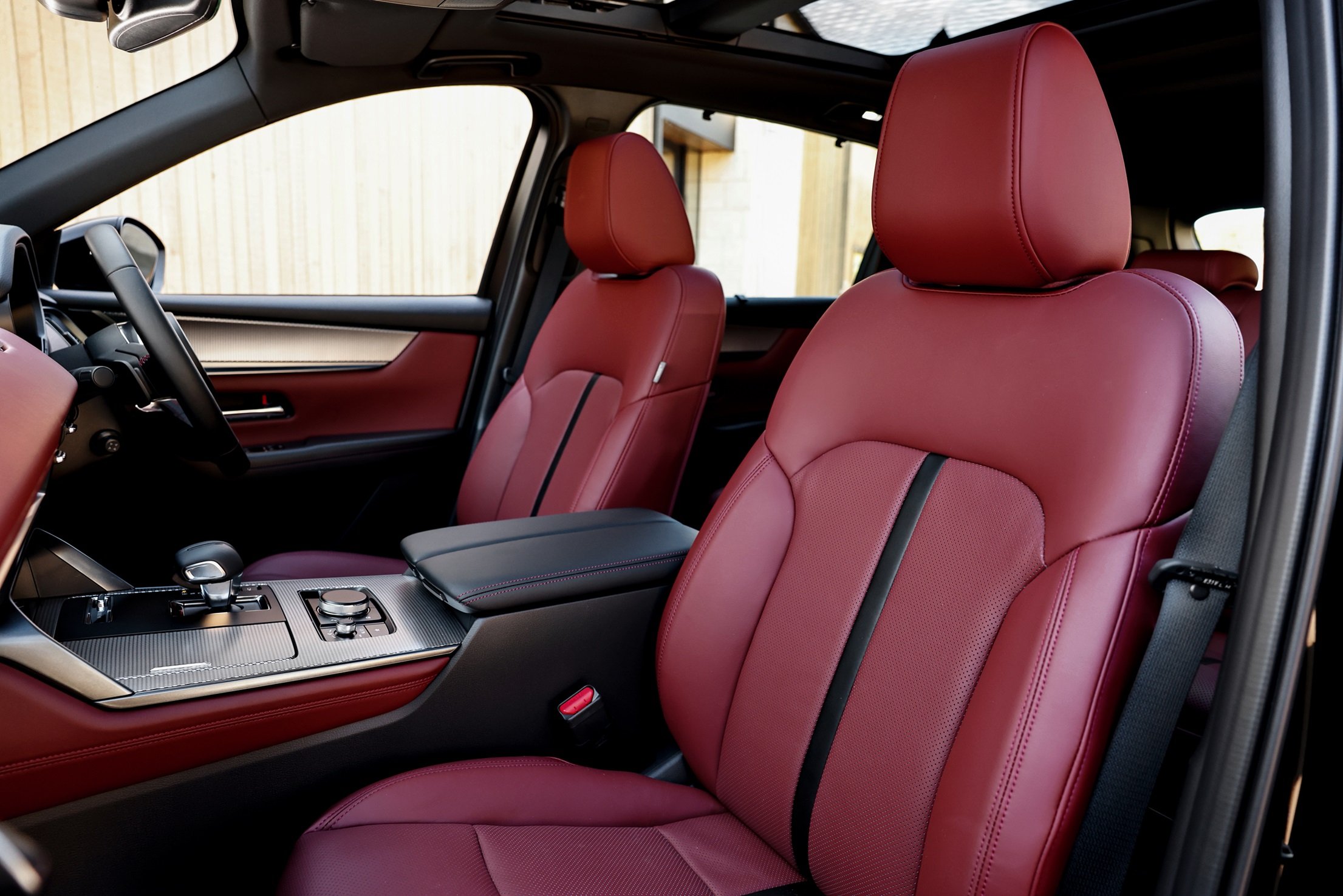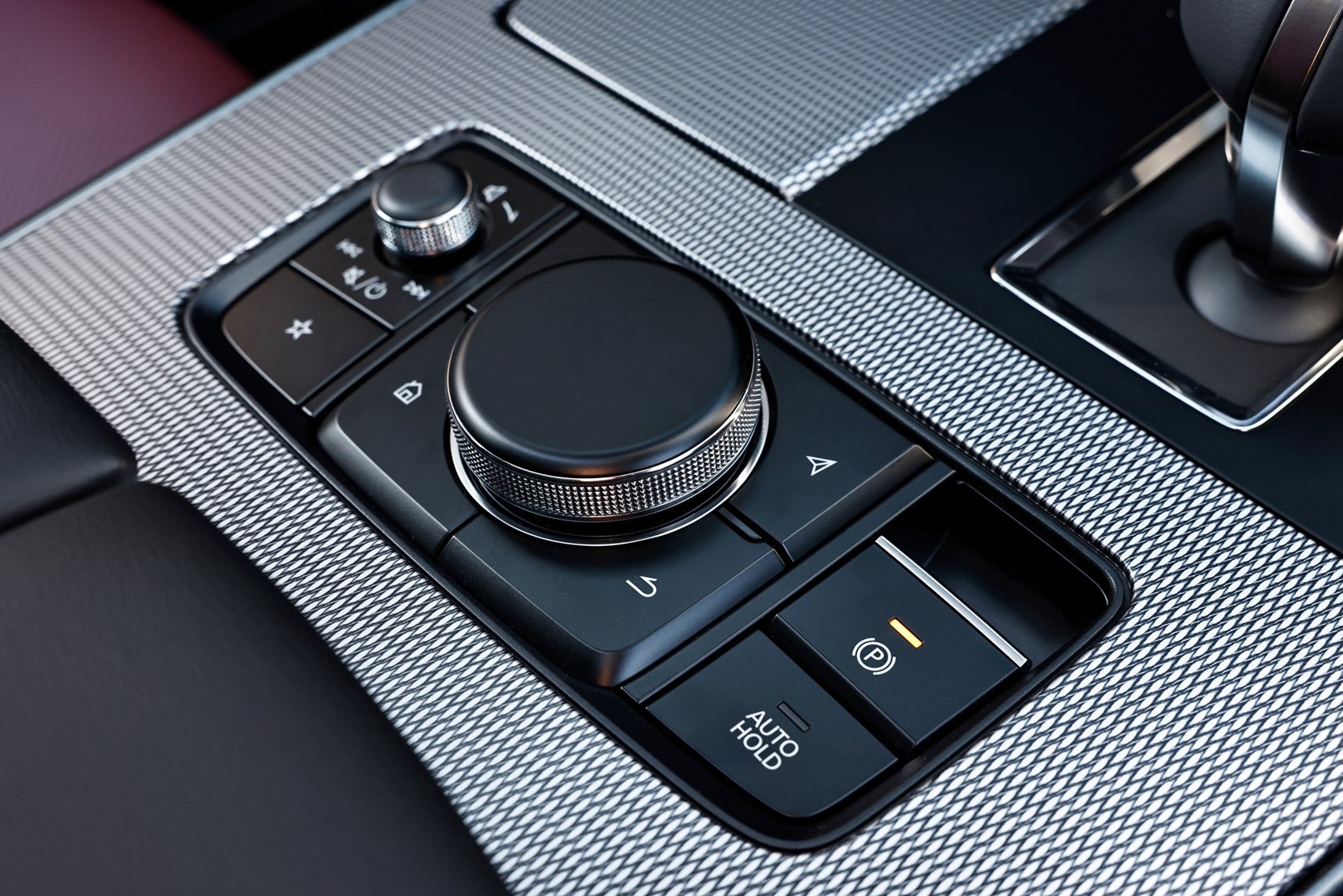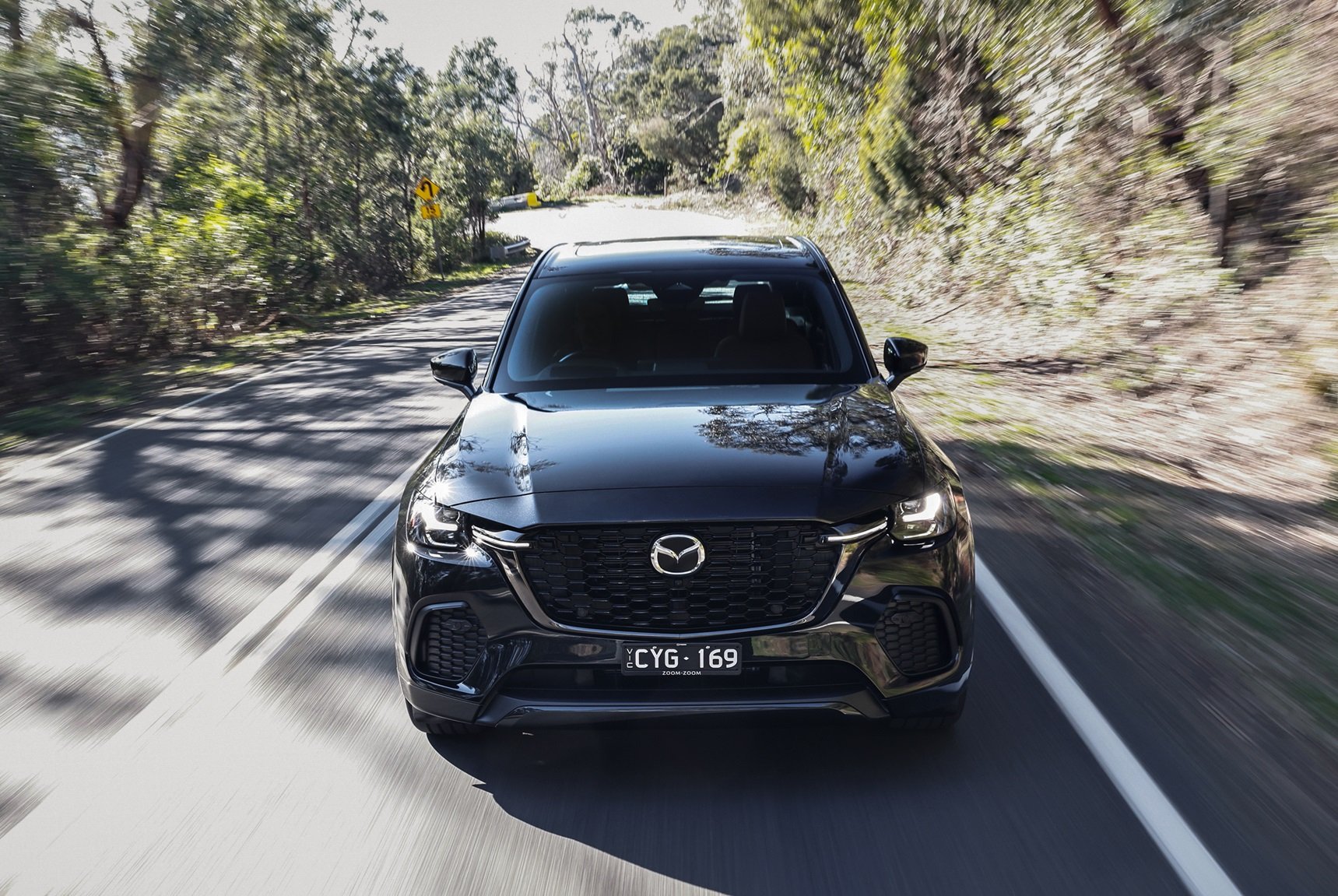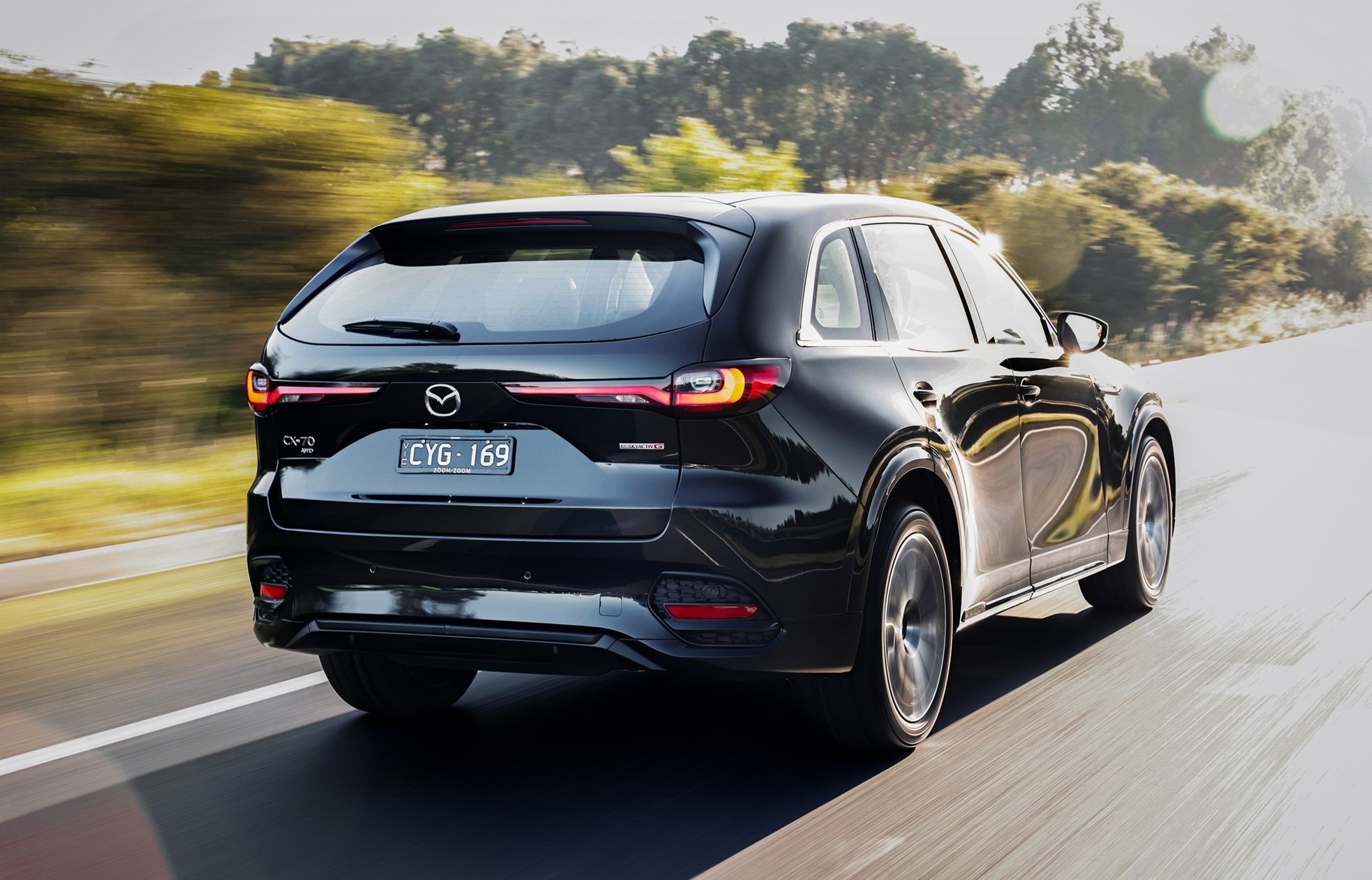Mazda CX-70 review and buyer’s guide
Mazda’s CX-70 is a large five-seat SUV with generous legroom, loads of equipment and a supremely comfortable ride. It’s one of four new additions to the brand’s prestige model onslaught, but for a fraction the price of a premium German SUV.
The Mazda CX-70 is like the old CX-9 in size, but with the luxury dial cranked all the way up.
It’s a five-seat only grunt-factory thanks to a powertrain that defies the car industry trend of tiny petrol engines bolted to bulky electric motors and heavy, expensive batteries.
Instead of betting the farm on hardcore electrification, Mazda has stuck to what works and what sells - hybrids, diesels and petrol engines. And the CX-70 packs not only hybrid assistance, but also a rebellious choice of engines.
In a time where carmakers are obsessed with downsizing their engines, attaching huge batteries and ultimately increasing the weight, Mazda has resorted to just offering a punchy engine, wrapped up in an uber-comfortable interior with supremely good sound attenuation, and a little bit of hybrid help.
The CX-70 is one of four major changes to the Mazda SUV range, and effectively replaces the CX-5 and CX-8 with something much more accommodating of medium-sized families (needing no more than 5 seats) but whom might in fact need maximum leg and headroom - and a huge boot.
CX-70 is 5.1 metres long. That’s the same length as a Kia Carnival or more than a Ford Everest. It’s the same width as a Toyota LandCruiser. The wheelbase is 3.12 metres long, which is the longest of all three vehicles mentioned, and only 10mm (yes, 1cm) shorter in wheelbase than a Mitsubishi Triton.
But what’s appealing about the CX-70 is that it competes with the new Hyundai Santa Fe, the 2024-updated Kia Sorento, and the Subaru Outback to some extent, but with a Venn diagram overlap with prestige vehicles like the BMW X5, Volkswagen Toureg and Lexus RX.
The advantage with the Mazda is, of course, you spend tens of thousands less overall, while getting a very similar luxurious experience. It’s not quite the same, but it’s astoundingly close - you’d probably never tell the difference, as a consumer. That is, driving the CX-70 is as close as you can get to those notionally premium products starting at closer to $150,000.
The obvious drawback for most consumers is that the Mazda will lack some of the very specific details and perhaps niche factors that make a prestige vehicle what it is.
The ability for an X5 to perform more like a Porsche 911 on straight roads, then become sporty and dynamic on country roads, while feeling uber quiet and plush among city traffic - it’s wonderful. It’s like you’re driving noise-cancelling headphones - that’s the premium you pay for.
The CX-70 and indeed the rest of the new CXes in Mazda’s range don’t quite get that exquisite top-shelf premium feel - but that’s the point. You get, arguably, 80 per cent of the performance, comfort levels and certainly you get the better build quality. But it’s also $30,000 easier to get into the CX-70 than the Beemer or Lexus. It depends what you’re shopping for.
In simple terms, the CX-70 is a five-seat version of the seven-seat CX-90, meaning you get the same overall size, wheelbase and proportions, but with an enormous luggage space that isn’t hindered by the third row of seats in the 90.
Given the demise of the performance station wagon, this is, in some ways, the next best thing.
FEATURES & PRICING
There are only two model grades in the CX-70 range which makes life impossibly simple when it comes to deciding what you want from this high-riding luxury 5-seater.
There’s the ‘base’ model GT, which is anything but base. It’s a rounded-up $76,000 (before on-road costs) for the turbo-petrol GT, or another $2000 for the turbo-diesel at $78,000 (pre-ORCs), both of which are all-wheel drive.
CX-70 ‘GT’ | G50E (petrol) $82,000 (d/a) | D50E $84,100 (d/a)
You get:
12.3-inch full colour widescreen display (Mazda Connect) and 12.3-inch TFT LCD multi-information meter display
21-inch Black metallic alloy wheels
Adaptive LED Headlamps (ALH)
Panoramic sunroof
Personalise system (auto restoration of settings)
Premium 12-speakers Bose stereo with amplifier
360-degree camera
Active driving display
Apple CarPlay and Android Auto (wireless and USB)
Hands-free remote operated power tailgate (open/close)
Leather seats with power adjustment (driver & passenger) and position memory (driver)
Heated seats (front and rear)
Heated steering wheel
Then there’s the Azami which is $83,000-85,000 (before on-road costs) depending on your choice of petrol or diesel powertrain respectively.
CX-70 ‘Azami’ | G50E (petrol) $92,550 (d/a) | D50E $94,100 (d/a)
For that extra $7000-8000, you include:
360-degree View Monitor with See-Through View
Ambient lighting
Black nappa leather or optional Burgundy nappa leather seat trim with quilting (at no extra cost)
Body-coloured wheel arches and lower cladding
Cruising & Traffic Support (CTS)
Frameless interior mirror
Interior foot lamp (front and rear)
Personalise system with Easy Entry & Driving Position Guide
Ventilated seats (front)
Body-colour exterior side door handles
When you choose the Azami, an optional SP Package is available for a further $3500, which offers:
Tan Nappa leather seat trim
Suede finish dashboard panel
Two-tone colour steering wheel
All up, you can potentially outlay over $90,000 for a CX-70 Azami with the SP Package, once you include on-road costs.
INTERIOR
Mazda’s interiors have been some of the nicest among the mainstream brands for the last decade, pretty much since the 2015 CX-5 and 2016 CX-9 arrived and forced other carmakers to lift their game.
The CX-70, along with its siblings in Mazda’s bold new luxury-specific models like the CX-60 and CX-90, continue this trend of upending the old convention that so-called ‘prestige’ German marques and even the likes of Lexus and Genesis, are old hat.
CX-70 offers thick slabs of good quality leather (as is the case with the rest of their leather interiors), with a generous helping of premium-touch surfaces like soft dashboard leather, textured plastics and brushed aluminium-style trims.
Unlike the Korean brands, Mazda is restrained in the overuse of glossy piano black which is desperately prone to finger prints, dust and looking filthy if you even look at it wrong. So Mazda gets points for using a different type of material around the transmission selector.
What’s interesting about the CX-70 interior is the balance Mazda has struck between aesthetically pleasing lines and design, without being tempted to over design. This is something the likes of Kia and Hyundai can fall victim to - putting in too many lines, too many surfaces, too many shapes, textures and things to look at.
Mazda takes the minimalist’s approach but without coming off as boring or lazy or simply lacking imagination in the manner of Tesla. The way the centre leather dashboard piece wraps around the start button and hazards button is beautifully finished. Then there’s the way the rear panel on the centre console, which is the control panel for row-2 A/C and USB points isn’t just a flat vertical facia, it rakes rearward with a mild convex arch. Subtle.
Then there’s the way Mazda takes the time and effort to put a conventional shroud or binnacle around the driver’s LCD display which blocks reflective light - unlike Kia and Hyundai which just stick a dirty big panoramic screen into the dash and walk away thinking that’s good enough.
And even the rear backing on the front seats is actual leather, not some textured plastic to cheapen the look. All of these design choices, and more, are what make the CX-70 actually feel special in the context of the ‘affordable luxury’ crowd of mainstream brand offerings.
The primary touchscreen is only a touchscreen when using smartphone mirroring, and defaults to the rotary dial for everything else.
Credit also needs to go to Mazda for fitting CX-70 with extendable sunvisors - finally. This is a move Hyundai and Kia made almost a decade ago with pretty much all their vehicles, even $35K Ceratos have it. But none of the other mainstream brands have caught on to what is such an easy, low-cost upgrade to offer.
So don’t be overly full of praise for Mazda, because yes, they have given you that option to block out late afternoon and early morning glare, they just aren’t the first to do this. But the fact they’ve now added that low-tech feature when so many other brands won’t, it’s a welcome one.
Points also go out for the hinge system on the rear doors which allow them to open at a 70-80-degree angle - not quite 90 degrees - but very close. This is such a saving grace when you’re trying to install child restraints and generally pack the vehicle for long journeys. Just be mindful they don’t get opened into neighbouring cars or carpark bollards.
I'll help you save thousands on a Mazda CX-70
Just fill in this form.
No more car dealership rip-offs.
Greater transparency.
Less stress.
ENGINE
The powertrains offered in these new Mazda SUVs are truly exciting, even for car enthusiasts who might shun a big, heavy SUV.
Carmakers, in recent years, dived headlong into the EV craze, reducing engine size in their range to remarkably small capacities, so they could then introduce batteries and electric motors to reduce their overall emissions across their model range. But Mazda has gone in a different direction.
They still have to work on reducing their corporate average fleet emissions, which is why the CX-70 is a mild hybrid, but it’s also a pretty big engine in a sea of tiny ones. And none of the other mainstream brands does an inline six anymore.
Launching not one but four big-capacity combustion engined models in 2024 seems bizarre, and yet tantalising. This engine is a 3.3-litre inline-six, and it’s all-new, offered in petrol or diesel form, both turbocharged for increased volumetric efficiency. You can also have a plug-in hybrid.
Click here if you want to understand why inline sixes are so perfect >> in a technical sense. But here are the headline facts you need to know about these powertrains.
The CX-70 petrol is about performance. The inline-6 e-Skyactiv G (for gasoline) is a turbocharged petrol engine making 254 kW of power (what HSV used to achieve with a 5-litre V8) and 500 Newton-metres of torque, meaning it’s able to do 0-100km/h in 6.8 seconds. It runs on 95 RON fuel, too, and consumes about 8.1 litres per 100km - which is almost 50 per cent more than the diesel.
The inline-6 e-Skyactiv D turbo diesel engine shortens your journeys with a punchy 187 kW of peak power at just 3750 revs and a surge of 550 Nm of torque, reaching 0-100 km/h in an effective 8.3 seconds. The torque is so applicable and useful to move this brute along you’ll wish there was a bigger boat on the back. (We’ll get to that.)
All this power is a pretty big deal by today’s standards, particularly given the emissions regulations in play currently. German brands peak at around 3.0 litres, although typical of Mazda to offer higher-capacity units such as the current 2.5-litre turbo four-cylinder in CX-5. Only Subaru still runs an engine that big among the mainstream brands. Same goes for the BT-50’s Isuzu-derived (and rather ancient) 3-litre diesel.
So which engine would you pick, notionally? Well, that depends on you…
The facts and figures on these new engines are impressive, but so is the inherent design of the straight-six.
An inline-six has a firing order that is mirrored on the opposite side of the cylinder bank, so the reciprocating forces are balanced out - meaning no balancing shafts or counter weights are needed to prevent the engine tearing itself apart. No counter weights means less reciprocating mass, less vibration, and of course - less weight. This increases longevity, allows you to increase the power without any inherent side effects, and it’s just smooth to drive.
Inline sixes are also less complicated thanks to having one cylinder head and just two camshafts - fewer parts, less to fail.
The (diesel) D50e offers that beefy 550Nm of torque, which is what you want for big holiday trips with lots of kids, heavy luggage bags, Eski and effectively half your house (or so it feels like) shoved in the back for a long weekend or school holidays away. You might also add roof racks and a luggage pod, possibly a bike rack on the back or a light trailer.
All of this kind of family use is screaming, ‘Get the diesel.’ Not only is diesel the more efficient fuel (because it has greater energy density: more energy derived per unit of fuel), but that torque is what you’re going to use to get the big, heavy mass going from the lights, but also on long, steep hills, overtaking trucks and any kind of towing or payload assignment.
Performance is very respectable, especially with all of that torque, but fuel economy is outstanding in the context of its kerb weight and the level of luxury.
The performance petrol version attracts Luxury Car Tax while the diesel does not, thanks to the latter’s good fuel economy. Think of the G50e as like an X5 M-sport style equivalent, but without the $154,000-ish pricetag attached, that includes about $14,000 in LCT. The Mazda attracts just $1000 in LCT.
Mazda says the diesel offers the lowest official consumption average of any other vehicle in its class (excluding hybrids), with a rating of just 4.9L/100km. That’s incredible for this size engine and for its outputs - and we have the nature of it being a more energy-dense hydrocarbon fuel to thank for that. (It’s why diesel fuel isn’t going away in Australia >>)
The petrol version, the G40e, develops 254kW of peak power which comes in at 5000-6000 RPM, and 500Nm of torque available at just 2000 RPM. That’s seriously impressive - for something as civilised and family-conscious as this. It makes 90 per cent of the BMW X5 M-sport’s power, but for roughly 60 per cent of the price. That’s value.
Fuel consumption is reasonably low, too, considering the engine size and power, with an official rating of 8.0L/100km. The X5 M-Sport in the same class, makes 280kW, but consuming 9.3L/100km. That’s 90 per cent of the performance, drinking 16 per cent less fuel (using the combined cycle lab test claims).
If keeping your outright fuel bills as low as possible is a goal (having spent $90,000+ on a vehicle), then you need to take a look at the diesel.
Mazda's 3.3 inline-6 turbo-diesel makes 187kW at just 3750 RPM. That means it’s 23kW down on the entry-level BMW X5 diesel, but only 9kW down in terms of power-to-weight ratio - meaning the BMW is 4kg heavier, but makes enough grunt to compensate. The CX-70 makes 88 per cent of the X5’s grunt, for just 60 per cent of the price.
Hyundai’s Santa Fe hybrid offers similar dimensional size, luggage and refinement as the CX-70, and the same fuel economy as Mazda’s inline-six diesel. But the Santa Fe has the advantage of offering instantaneous torque from zero revs.
For CX-70, its official combined cycle fuel economy claim is 5.4L to the Azami diesel, and it’s 5.6L to the Santa Fe Calligraphy with its 1.6 turbo-petrol hybrid that makes a combined power output of 174kW.
In power-to-weight ratio, the Santa Fe is only 5kW per tonne less than the CX-70, but offers those very handy row-three seats. And it’s $12,000 cheaper than the Mazda. But the CX-70 is a completely different vehicle to drive. It feels like a German SUV that celebrates driving (but up high and with the kids on board) compared with the hybrid Santa Fe which offers supreme comfort and quietness, albeit without the plushness of the CX-70 - but it’s remarkably close.
So the CX-70 absolutely outpaces the Santa Fe Calligraphy, and can tow 50 per cent more weight (notionally), but the Santa Fe offers more luggage volume in the boot, and is 5 per cent lighter.
Overall, the CX-70 sits in a niche above the ordinary large SUVs from Hyundai, Kia, Toyota and Mitsubishi, outpacing them in raw performance and tangible luxury, but the beefy Mazda also embeds itself uncomfortably close to the elite brands like Merc, Audi and BMW. It makes them look overpriced and like they’re trying a big too hard.
An certainly your Mazda CX-70, it must be said, is going to be more reliable than an Audi Q7, Mercedes GLE, and probably also the X5 as well.
TRANSMISSION
Mazda’s decision to stick with epicyclic automatic transmissions with torque converters is what has made them quite good in both highway driving and city commuter traffic.
The CX-70 gets an 8-speed auto that, like the CX-60 and 90, is so quick on upshifts it feels like a single reduction-type gearbox like you get in EVs, and then on the way down, it’s smooth and doesn’t lurch you forward under longitudinal negative-G. The brakes do, but that’s only because they’re doing what they’re supposed to do: bring this 2.2-tonne vehicle to a stop.
Hitting the brakes will tip kinetic energy back into the 48-volt battery system to reuse it during idle and heavy load such as taking off from stationary.
Stop-start city driving with Mazda’s transmissions is generally a very smooth experience. Statistically, they never mis-shift ever, they’re always in the right gear, and know instinctively when to kick-down upon request with your right foot to accelerate, such as to overtake on the freeway.
It’s a very hard gearbox to trick or confuse, and nor does it hunt around for the right gear.
In terms of offering that refinement of a nicely tuned transmission that responds to your inputs, Mazda is hard to beat, even on an inline-six turbo-diesel.
It’s also worth appreciating that Mazda hasn’t felt the need to reinvent the transmission shifter, so to speak, by putting a stalk on the steering column where you can’t find it, get confused about which way to twist for ‘drive’ or ‘reverse’ and then bash it with your knee because of your long legs.
They’ve left it on the central transmission tunnel, but they’ve made it smaller, given it shape and a refined, super-slick shift. And the action itself feels solid, yet easy. It doesn’t feel mechanical, despite the fact you are very much using your hand to notch it into ‘D’ or ‘R’.
You can also revert to the paddle-shifters behind the steering wheel, however, their general location for your fingers might be comfy or cramped depending on how big your hands are and how long your fingers are.
Downshifts are a nice balance between engaging for the driver and smooth enough that there are no weird feedback effects. Feeling the ‘old school’ nature of the rear-biased AWD means you feel stable and flat on twisty, downhill braking sections while changing down the gears.
As opposed to front-biased systems of old where the front tyres feel like they’re dealing with too much input at once: steering, gear changes and braking - which can lead to understeer.
TOWING
Towing and payload are inexorably tied together because the trailer is restrained by the vehicle and becomes part of the payload. The GVM is 2722kg, and payload capacity is 506kg, meaning that if you were to load up to that maximum payload (including kids, luggage etc) you’re left with 2216kg - the exact kerb weight.
The maximum braked towing capacity of CX-70 is 2500kg, which, hypothetically, would put a notional 250kg of download on the towball. Except you can’t because the CX-70 is limited to just 150kg on the towball, which means a potential of just 6 per cent of the trailer restrained by this 2.2-tonne vehicle.
This means two things. First, that if you add a trailer that puts 150kg on the towball, which is counted as payload, you’re limited to just 356kg of payload. If you, the driver, weighs 100kg, you’re left with 256kg for your family: the wife, the kids, all your stuff - and any accessories you might’ve liked to include. This might include roof racks, luggage pod, whatever.
To put it simply, you can’t feasibly maximise the towing and the family payload. You can max-out one and minimise the other - but can’t really do both. That’s okay, because it doesn’t render the CX-70 useless. Quite the opposite. It just means you and your family are supremely comfortable, while also towing a light box trailer with a bunch of stuff in it.
The second result of these sums is that restraining a 2.5-tonne load with just 150kg borne by the CX-70 is potentially an unstable combination, perhaps in the wrong extreme conditions, or in the event of some kind of emergency braking or swerving manoeuvre. So it’s fine to do it, just be cautious, be conservative.
Towing is still possible, obviously, you just need to make absolutely certain that it’s a conservative combination. Avoid going over the 2000kg watermark to make sure you remain well inside the safe working limit.
FUNCTIONALITY
The doors on a Mazda CX-70 open at a damn-near perfect 90-degree angle. That’s a huge victory for mums and dads who have to deal with child restraints, especially adults on the taller side who can find themselves trying to slip their large frames between the C-pillar and the rear door frame while trying to get their kids in and out.
Having doors open as such a useful angle also makes cleaning the car significantly easier. Getting into the footwell, removing floor mats and trying to fetch any fallen toys or shoes or food from under the front seats - all made easier by doors that actually open and get out of the way.
Unfortunately the CX-70, which is a 7-seater without the 6th and 7th seat (because it’s effectively a CX-90 minus row three), has an enormous boot space - but they’ve only managed to get a space-saver spare wheel under the floor.
This is a packaging thing Mazda has done for years, sticking only space-saver temporary spares into even its biggest SUVs, and with all-wheel drive. It’s not entirely bad news, because it does mean more space for designing the actual vehicle, and punctures are statistically fairly rare - and if you’re a Mazda customer, chances are you’re using it in places where a tyre shop isn’t far away.
It’s also unlikely you’re looking to take your CX-70 into the outback, but certainly regional touring can be tricky getting around on a temporary spare limited to 80km/h. A space-saver does, of course, help Mazda (rein in the weight a little bit) and save space .
The CX-70 gets 598 cubic litres of volume behind the back seats. That’s just 52 litres shy of the $150,000 BMW X5 base model, or a difference of just 8 per cent. However it is also less than the 628 litres on offer in the Hyundai Santa Fe, which also gets additional functionality of row-three seats for about $12,000 less than the CX-70. And the CX-70 isn’t exactly going to be significantly better on fuel economy than the hybrid Santa Fe.
Unless you don’t care about fuel economy much, in which case, the Mazda is certainly going to be more engaging to drive as opposed to silent at low speeds in the Hyundai. It depends what you enjoy.
The CX-70 gets three top tether anchor points on the back of row two, two of which are in plastic guides and one partially hidden behind a slit in the backing fabric. Two pairs of outboard ISOFix points are also in guides in row 2.
A 220-volt 3-pin plug outlet capable of 150 Watts of draw can be found in the boot (that’s good enough to run most portable fridge/freezers and automotive air compressors), as well as the typical 12-volt round power outlet.
There’s also a hidden storage compartment under the rearmost section of the back row of seats, which you can only access by tilting the whole seatback forward in order to release the lid from being captured by the seat’s reclined state. Additional underfloor storage can also be found when you lift the luggage compartment floor.
That floor, by the way, must be over a metre long to the bottom of the seatbacks.
DRAWBACKS
The glaring downside to this impressive, luxurious range of big new family Mazdas is - they’re all given space-saver spare wheels.
Now, for many, this may not be a problem in the majority of daily routine driving you’re likely to do within the outer edge of most metropolitan cities where there’s a tyre shop or mechanic around that can help if you get a flat.
But in the case of actually wanting to visit regional tourist destinations, which can be hours between towns, especially on weekends and public holidays when everything is closed after 5pm and doesn’t open before 9, if at all on Sundays - a temporary spare can be a problem.
Besides just the gross inconvenience, it’s also the technical limits it puts on the vehicle. Getting around on a doughnut, with 500kg of family, luggage and push bikes, on potentially sketchy backroads, in the rain, or on dirt roads, or getting out of the sandy beach carpark can be hard work on the spare.
Also, you’re an additional 500kg heavier, and supposed to be running in AWD, in some conditions, meaning the space-saver is doing more work than the standard 21-inch alloy wheel and tyre. Speaking of, space-savers are limited to 80km/h, so getting home can be slow.
MAIN COMPETITORS
Here are the key specifications on each of the Mazda CX-70’s main market rivals which you might compare it to in both the mainstream brands and the prestige brands Mazda wants to disrupt.
BMW X5 xDrive 30D xLine | diesel | $134,900 before on-road costs (approx.)
PERFORMANCE
Engine: 3L turbo in-line 6 || Power: 210 kW @ 4000 RPM || 650 Nm @ 1500-2500 RPM || Power-to-weight ratio: 97 kW/t || 0-100km/h: 6.1 sec || Fuel cap.: 80L || Combined fuel consumption: 7.8L/100km (claimed)
Driveline: Permanent AWD 40:60 (front:rear), 8-speed epicyclic sports-automatic
SIZE & WEIGHT
L: 4935mm W: 2004mm H: 1765mm || Wheelbase: 2975mm
Kerb weight: 2220kg Turning circle: 12.6m Ground clearance: 216mm
Luggage space: 650L (row 2 up), 1870L (row 2 down)
Towing: 2700kg braked (180kg towball d/load) | Max payload: 544kg | GVM: 2950kg
DRAWBACKS:
Runflat spare tyre
Max. towball download only 180kg (just 6% of the maximum towing capacity)
$13,000 Luxury Car Tax
OPTIONAL EXTRAS:
Adaptive self-levelling air suspension | $2500
Premium Bowers & Wilkins ‘Diamond’ surround sound | $8000
Comfort pack: Heated steering wheel, quad-zone climate control, heated/cooled front cupholders, ehated row 2 seats, row 2 sunshades | $3800
Executive pack: Ventilated/cooled front seats, premium 16-speak stereo, massaging headrests, tinted glass roof | $8500
Enhancement pack: premium 16-speak stereo, tyre pressure monitoring, 22-inch alloy wheels, metallic paint | $6000
AUDI Q7 45 TDI | diesel | $117,300 before on-road costs (approx.)
PERFORMANCE
Engine: 3L turbo in-line 6 || Power: 170 kW @ 3500-5000 RPM || 500Nm @ 1500-3000 RPM || Power-to-weight ratio: 70 kW/t || 0-100km/h: 7.1 sec || Fuel cap.: 85L || Combined fuel consumption: 7L/100km (claimed)
Driveline: Permanent AWD, 8-speed epicyclic sports-automatic
SIZE & WEIGHT
L: 5066mm W: 2018mm H: 1707mm || Wheelbase: 3005mm
Kerb weight: 2465kg Turning circle: 12.4m Ground clearance: 200mm
Luggage space: 740 L (row 2 up), 2050L (row 2 down)
Towing: 3500kg braked (350kg towball d/load) | Max payload: 544kg | GVM: 3000kg
DRAWBACKS:
Tyre repair kit
$7000 Luxury Car Tax
Poor customer service and reliability
MERCEDES-BENZ GLE 300d | diesel | $134,900 before on-road costs approx.
PERFORMANCE
Engine: 2L turbo in-line 6 || Power: 170 kW @ 3500-5000 RPM || 500Nm @ 1500-3000 RPM || Power-to-weight ratio: 70 kW/t || 0-100km/h: 7.1 sec || Fuel cap.: 85L || Combined fuel consumption: 6.6L/100km (claimed)
Driveline: Permanent AWD, 9-speed epicyclic sports-automatic
SIZE & WEIGHT
L: 4924mm W: 2010mm H: 1790mm || Wheelbase: 2995mm
Kerb weight: 2512kg Turning circle: 12m Ground clearance: 200mm
Luggage space: 630 L (row 2 up), 2055L (row 2 down)
Towing: 2700kg braked (108kg towball d/load) | Max payload: 588kg | GVM: 3100kg
DRAWBACKS:
Space-saver spare tyre
Max. towball download only 108kg (just 4% of the maximum towing capacity)
$20,000 Luxury Car Tax
Poor customer service and reliability
HYUNDAI SANTA FE
PERFORMANCE
Engine: 1.6L turbo 4-cylinder hybrid || Power: 172 kW @ 5500 RPM || 529Nm @ 1500-4500 RPM || Power-to-weight ratio: 83 kW/t || 0-100km/h: 10 sec approx. || Fuel cap.: 67L || Combined fuel consumption: 5.6L/100km (claimed) | Fuel: 91 RON
Driveline: Full-time AWD, 6-speed epicyclic sports-automatic
SIZE & WEIGHT
L: 4830mm W: 1900mm H: 1770mm || Wheelbase: 2815mm
Kerb weight: 2105kg Turning circle: 11.6m Ground clearance: 177mm
Luggage space: 628 L (row 2 up), 1949L (row 2 down)
Towing: 1650kg braked (100kg towball d/load) | Max payload: 575kg | GVM: 2680kg
DRAWBACKS
Only 100kg towball d/load (6%)
Very low towbar attachment relative to the ground
CONCLUSION
The Mazda CX-70 is a genuine contender in the luxury large SUV space - because it defies the conventions established by other brands which have dominated that market niche for decades.
But luxury isn’t unobtainable anymore, especially for a brand like Mazda with resources and cache built up over the last 15-20 years making reliable, affordable but very well equipped cars. This all started with the current-generation CX-5 (soon to be replaced) and the recently superseded CX-9 which really did break the ‘affordable luxury’ mould.
CX-70 is effectively a CX-90 with only five seats, not seven. If you like the CX-70, but do think having an extra pair of positions for posteriors, the CX-90 is a good choice for big families that often involve kids’ sleepovers and gatherings interstate, or possibly because roadtrip school holidays are your reality.
But if you like the idea of a five-seat midsize SUV, but simply want more legroom, great luggage space and luxury over macho towing/soft-roading type driving, then the CX-70 is a sweet spot for maximising comfort.
It also says something significant if Mazda is will to bet the future of its new large SUV line-up on a grunty, bigger-capacity straight six engine that is reminiscent of a bygone era where families cars could come with a honking engine.
Especially if it goes against the notion of (seemingly) everyone else in the car industry as they go electric and hybrid.


